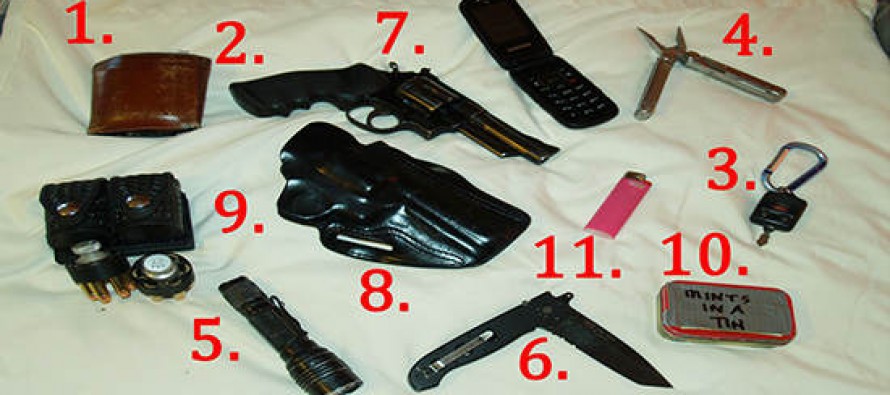by Bob
If one looks at our current times through any manner of lenses-economic, political, spiritual, societal, and especially through God’s Word, it certainly appears that tough times are around the corner. How soon we do not know, but it seems that we will face many changes and challenges and more likely sooner than later.
One of the first projects a burgeoning prepper tackles is a “go” bag, or a “get home” bag to ensure they have what they need in close proximity to provide for foreseen and unforeseen obstacles in the event of an emergency. Right alongside one’s go bag in importance is what one carries on one’s person daily.
If you’ve got a concealed weapons permit, EDC, or Every Day Carry, immediately evokes thoughts of the gun one carries daily. There is much more to EDC, though, than a concealed handgun.
1. First on The List of EDC Items is Cash
In a time of crisis debit and credit cards may not be useful if the grid is down in your area. Cash assures that you will still be able to transact for necessaries like fuel and other items to make it home. Each of us must decide how much is enough and how much we can afford to set aside for such. In my situation $100 to $200 in twenties seems to be a good number, but i don’t have a long commute. While two hundred bucks might seem like a lot of cash to carry around, I know that if something happened and I couldn’t make it home in a day’s walk, I would have money to arrange a night’s stay, buy extra food or fuel, or pay for a ride from a passerby.
2. Next of Course is ID…
…like your driver’s license – and your debit/credit card. If you drive, these are necessary items and while they’re obvious, they’re still part of our every day carry. Alongside that, I guess we should mention the dreaded cell phone. I prefer the out-dated flip style phone simply because they break less than the flat phones, are easier to keep in a pocket and are much simpler to use.
3. Included in My EDC Kit is Keys of Course
I keep my keys on a carabiner that I clip to a belt loop, simply because I have probably too many keys on my key ring. And as you will learn as you read on, I have little pocket-space to spare!
4. My Trusty Leatherman Wave Pocket Tool
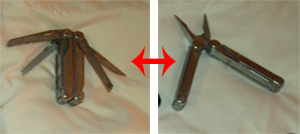 I’ve been carrying one for more than fifteen years, and the times I’ve used it is beyond count. I’ve done everything from trim my mustache in the dentist’s parking lot to repair fencing with it. Even impromptu auto repairs will quickly demonstrate the utility of such an implement. There are all kinds of pocket tools out there, and to be honest, my first “pocket tool” was a Swiss Army knife I bought way back in the day for about thirty bucks. The pocket tool far surpasses the swiss army type knife though in terms of utility, versatility and durability. I tried carrying my pocket tool for a while on my belt in a neat little basketweave holster, but eventually I decided it was easier for me to carry in a pocket.
I’ve been carrying one for more than fifteen years, and the times I’ve used it is beyond count. I’ve done everything from trim my mustache in the dentist’s parking lot to repair fencing with it. Even impromptu auto repairs will quickly demonstrate the utility of such an implement. There are all kinds of pocket tools out there, and to be honest, my first “pocket tool” was a Swiss Army knife I bought way back in the day for about thirty bucks. The pocket tool far surpasses the swiss army type knife though in terms of utility, versatility and durability. I tried carrying my pocket tool for a while on my belt in a neat little basketweave holster, but eventually I decided it was easier for me to carry in a pocket.
I imagine there is a designer at Leatherman somewhere that would beam with pride to see how well used my Wave has become, knowing that it has ably served its mission. One thing I really like about the Wave is that its outer blades/saws/files can all be accessed one-handed. In the spirit of redundancy I also keep a pocket tool in my go bag.
5. The Flashlight
Its pocket sized with the girth of about a 25 cent piece, has a pocket clip for easy access and throws 600 lumens. It also has bevels on the lens cap which are there I assume to serve as a glass breaker. Its easy to imagine the bevels might also make the flashlight useful as a weapon. It has three settings-high, strobe and low, with the power button at the back end.
The strobe function theoretically could disorient an assailant by messing with their brain’s alpha waves. I’ve never experimented with the strobe on my flashlight to achieve that effect, but anyone that has encountered the nausea and disorientation of being “strobed” knows what that’s like. I experienced it driving on a long steel bridge at 55 mph crossing the Columbia river near sundown-the alternating blast of sunlight and shade from the bridge’s beams strobed me right into the nausea and disorientation of the strobe effect. It took quite a bit of concentration and effort to get my self off that bridge.
I’ve tried smaller pocket flashlights, but to be honest the size of my current light enables me to access and use the light easily with my thick fingers. The one downside of the light I carry daily-it uses the CR123 batteries, which are a bit more expensive and a bit harder to find than your regular AA or AAA batteries. One can easily find on the internet instructional videos on how to use a flashlight in conjunction with a handgun. There are a couple of main styles, but I prefer the wrists-crossed method. Without belaboring the point, I cannot stress enough how important a flashlight is in one’s EDC kit. Get a Free Tactical Flashlight here.
6. In Addition to the Pocket Tool, I Also Carry a Folding Knife
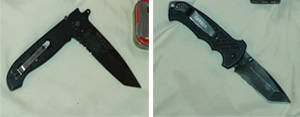 Musts for folding knives:
Musts for folding knives: - pocket clip for easy access
- one handed operation like a thumb stud
- durability
- a portion of the blade to be serrated
The serrated portion will zip through with ease that which a regular straight blade will struggle. I prefer a tanto style blade for the strength inherent in the design, although a tanto blade with serrations is a little more time consuming to sharpen than a regular blade.
My folding knife goes everywhere with me and it spends more time in my hand than any other thing in my pockets-from cutting hay bale strings to opening the coffee pouches at work it, definitely is well used. I also don’t keep my folding knife “razor” sharp. I’m a meat cutter by trade and I have knives I keep that sharp, and I would certainly use them for dressing game or such a task. I keep the pocket knife a little less sharp simply for safety’s sake-not for mine per se, but for if I hand it off to a buddy or a family member. After cutting meat for thirty years I’m wary of those that don’t know how sharp a really sharp knife can be and it can cause accidents. A few passes on the rough stone keeps it in a good balance between usefulness and safety for me. I won’t belabor the necessity of one-handed operation of a folding knife. I will let you imagine why that is a good idea.
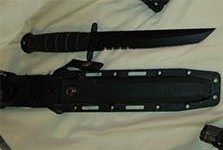 All that said, when I’m at home and not in the public purview, I prefer a fixed blade knife because its even more “one handed” and it can do a little bigger work than a folding knife can, but most municipalities prohibit the open carry of a fixed blade knife (see picture).
All that said, when I’m at home and not in the public purview, I prefer a fixed blade knife because its even more “one handed” and it can do a little bigger work than a folding knife can, but most municipalities prohibit the open carry of a fixed blade knife (see picture). 7. The Handgun
Some people believe in carrying a concealed handgun. Others prefer open carry. Others still refuse to engage in either practice. Here are some thoughts on why and what and how one should carry daily.
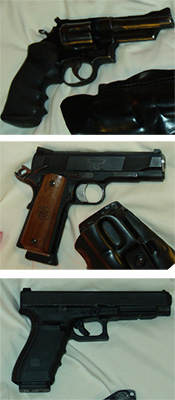 First of all, I generally carry only full sized handguns for either concealed or open carry. Here is why from a physiological perspective: in the event I am confronted by an assailant who appears to be presenting a lethal threat, that moment, by its nature will be a high stress event. When stress comes, adrenaline flows. When adrenaline flows, fine motor skills deteriorate. This means the smaller an object is, the more difficult it will be for me to properly acquire a grip and effectively use the object. We see the principle in effect in babies’ toys. The toys tend to be oversized which makes them more manageable to compensate for a lack of dexterity.
First of all, I generally carry only full sized handguns for either concealed or open carry. Here is why from a physiological perspective: in the event I am confronted by an assailant who appears to be presenting a lethal threat, that moment, by its nature will be a high stress event. When stress comes, adrenaline flows. When adrenaline flows, fine motor skills deteriorate. This means the smaller an object is, the more difficult it will be for me to properly acquire a grip and effectively use the object. We see the principle in effect in babies’ toys. The toys tend to be oversized which makes them more manageable to compensate for a lack of dexterity.
Another advantage is a full sized weapon is usually chambered for a full sized caliber, which means I am approaching my task with a near optimal tool. One main hindrance to carrying smaller weapons in smaller calibers is that sometimes these weapons can fail to cycle properly due to lack of energy generated by the detonation of the cartridge. If the gun jams at the wrong moment..well you can imagine the potential consequences. Calibers in this “too small” category include the .22, .25 ACP .32 ACP, .380 Auto. I’m not criticizing anyone’s preferences. I’m just giving the logic for my preferences. And again, handguns chambered in these calibers tend to be small, which may be disadvantageous in an adrenaline filled moment.
The downside to this idea is that I am carrying a heavier weapon that takes up more space and so may seem to be harder to conceal. I’ve learned to compensate by using well made holsters, adjusting my wardrobe accordingly (I’ve lived in Houston and also Las Vegas in the past, it can be done, even in hot climates), and buying well made belts. I prefer the horsehide belts-double thickness-made by an outfit in Tacoma. Adjusting my wardrobe has meant buying shirts a size or two larger than what I normally wear, buying pants a size big if I am going to carry inside the waistband (IWB), and always wearing a t-shirt of some sort to keep the weapon from directly contacting my skin (avoids sweat rusting the weapon, and creates a buffer for my skin against the various rough edges on the weapon).
Why you Should Carry
The main reason most folks choose to carry daily is obviously safety vis a vis personal protection. Most state and municipal codes allow for the use of equal force and when a threat becomes perceived as deadly, then one may use deadly force to counter the threat. Most of us who carry daily tread lightly and so use our situational awareness to avoid getting in a “tight spot” to begin with, and live in the world of “I pray I never have to use it. But at least I know its there if I do.” To that I would add that mindset is very important, and the carry-mindset must be:
“I will not allow another to harm me or my loved ones”.
All that said, there is another VERY important reason why you should start “carrying”- either open or concealed – as soon as practical. The day may come when you HAVE to carry a handgun every day, everywhere for your survival. If you’ve already been doing it, then obviously, it is no big deal…no change to what you usually do. If you are new to it, believe me, it will take you time to adjust to the weight and even discomfort of packing a handgun around on your belt. With many changes and events coming at you quickly this may prove to be quite hampering to some degree or another, depending on one’s fitness and ability to block out and to endure discomfort.
No joke-at first carrying a handgun is going to be uncomfortable. Your belt with bite into your sides, the gun will press against your hip, and you will have a minor shift in the center of balance. Now is the time to get your mind and your body tuned to the temporary discomforts and daily challenges that come with carrying a handgun. In time of course the discomforts fade and then it becomes noticeable if you are NOT carrying-kinda like when you can tell when you forgot to put your wallet in your pants pocket-it feels like something is missing.
If you don’t have a CCW already, you might think about getting on it quickly. If you live in a state that provides for open carry, you might consider that also. If neither are possible, do it in the confines of your home. It may seem awkward at first and you may feel a bit self conscious about it. That too will fade.
Along with the reasoning in the above paragraph, the sooner you start carrying, the more quickly you will determine which holsters in which styles suit you best in terms of comfort and utility. None of us would want to face – three months into a time of protracted difficulty – that the gear we chose was not suitable for the task. Find out now, while you have choices and you’ll save yourself the grief later. To get your body/mind in shape for it, and to work through what’s the best gear are to me the number one reason why you should endeavor to carry a handgun daily if possible as soon as possible.
Some tips on how to choose a defensive handgun:
- It must fit your hand appropriately.
- It also must be a “combat worthy” weapon. Combat worthy connotes that the weapon was designed for and likely used by major military/law enforcement organizations. This means the weapon endured considerable testing to assure its reliability and durability under adverse conditions.
- Acquire weapons chambered in calibers you will likely be able to forage/barter for in the event of protracted difficulty.
- Avoid under powered cartridges, and also overpowered cartridges. We already discussed the disadvantages of under powered cartridges. Overpowered cartridges inhibit your ability to place follow up shots due to heavy recoil.
- Buy a handgun in a chambering that you feel confident in your ability to manage. If the .45 ACP is a bit much, try a 9mm. For some, even the 9mm is too much recoil. I’d rather see a person outfitted with a .22 they feel confident with than a weapon in a larger caliber that scares them or they cannot physically manage-which is a direct contradiction to the prior caveat about underpowered cartridges…the art of the compromise. .Also, be advised that a heavier handgun will mitigate felt recoil better than a lighter gun chambered in the same caliber-the laws of physics in action
- “One is none and two is one”. With this in mind I believe it is better for me to own two of the same model than two entirely different models of handgun. For additional information for those new to firearms, read my previous article on the matter:
8. If You’re Carrying a Handgun, Obviously You Need a Holster
 There are many types of handgun holsters made with a variety materials. In short I prefer a pancake (belt scabbard) style holster made of leather that is cut and molded specifically for the weapon of choice (see picture). They allow for both concealed and open carry. I also like the kydex (plastic) holsters for their light weight and durability.
There are many types of handgun holsters made with a variety materials. In short I prefer a pancake (belt scabbard) style holster made of leather that is cut and molded specifically for the weapon of choice (see picture). They allow for both concealed and open carry. I also like the kydex (plastic) holsters for their light weight and durability.
I tend to avoid the “one size fits all” nylon holsters because, while they are usually the most inexpensive option, they just aren’t as effective for keeping the weapon exactly where I want it-although it is handy to have at least one for the sake of flexibility.
There are many inside the waistband holsters also, but since I grew a bit of a belly, I don’t use them as much. There are also paddle styles available as well that use a paddle that slips down inside the waistband to hold the holster in place. I’ve used shoulder holsters a bit, but I like belt styles better, and a quality shoulder holster can get a little spendy.
Lastly are ankle holsters. I don’t use them simply because to access my weapon I have to kneel down which makes one both temporarily immobile and quite vulnerable to one’s assailant. Some folks use them for a backup weapon like a small frame revolver, and I think there is some merit to that approach. Kydex holsters are an advantage because sweat won’t be rotting them out.
Many holster makers are now made with a small, paddle shaped flap of material at the top of the holster to prevent the weapon’s hammer and/or slide from cutting in to one’s side, so I generally look for holsters with that feature.
A good number of holster manufacturers thoughtfully include a screw through a rubber bushing that allows one to tune how tightly the holster holds the weapon.
Again, be sure you are buying a holster made for your particular gun, rather than the one-size-fits-all models. And if you have “one of those guns” that are hard to find holsters for, oftentimes you can find a holster made for a similar weapon that works just as well. For instance, the CZ 75 is hard to find holsters for, but it will usually fit well in a holster made for Browning Hi Powers. Some holsters come with active retention systems. You must decide for yourself if this is a benefit for you or not. Such holsters are usually made for the insurance requirements of law enforcement agencies and add another step, another thing to focus on and to properly execute-in what will very likely be a demanding and critical, adrenaline filled moment.
Also, some holsters allow for one to adjust the cant-the angle at which the weapon is oriented. Some prefer a forward rake, others prefer the weapon to be oriented vertically, and others still may prefer the weapon to be canted slightly rearward. Further, some folks may like the weapon slightly to the rear of the strongside hip, others directly on the hip, and some with the weapon stationed forward on the hip-appendix carry, so feel free to experiment with what feels most comfortable and suits your needs best.
One holster style that I’m a little hesitant to discuss is the “drop leg” or “thigh rig” style holster for daily open carry. They’re a little too tacti-cool for my taste. Nevertheless, I own a couple of them for the simple reason that in a WROL situation in cold weather where multiple layers are a must, the drop leg holster may be the most viable option. Lastly, put the value in the quality and durability of a holster rather than merely the price when shopping for holsters.
9. Magazine Carriers
Carrying extra ammo is always a good idea. Not for the sense of bravado mind you. Prepping by premise requires having at hand what one needs. Extra ammo on hand fits right in to the mindset. For those that prefer revolvers for EDC, there are holsters for speedloaders and looped holders for carrying individual rounds that fit right on the belt (picture a six round segment of an old west gunfighter’s belt).
Whatever route you go, do your best to get quality product that will last and that works for you.
Open vs. Concealed Carry
Open carry is what it says…that one is carrying a handgun openly without concealment.
The obvious advantage is very quick access to the weapon without having to sweep up or aside a covering garment. In states that allow open carry one doesn’t generally need any manner of permit to carry openly.
The down-sides are that knowing you are carrying a handgun can be off putting to some (which matters little to me as long as its legal but its still a thing to consider), and if everyone knows you are carrying you must be aware you have made yourself a target to the bad guys. If they’ve got ill plans and they see you are “carrying”, they know they have to take you out first. Also, standing in lines and other crowded situations means you must be extremely aware of who is “in your bubble”. The last thing you want is anyone trying to swipe your gun from you.
Concealed carry is also pretty self explanatory-one is carrying a handgun that is hidden from the view of others.
The upsides to concealed carry are no one, not even the bad guys, know you have the ability to defend yourself and so it gives you, the concealed-carrier, the advantage. As long as your weapon is properly concealed there is little chance that anyone will be the wiser and so you don’t have to worry about who might be “offended”.
The downsides-it usually requires a fee, some coursework and proficiency testing, and some period of wait time to get a concealed weapons license. Presenting from concealment can be a bit more cumbersome than presenting from open carry as you will have to uncover the weapon one way or another to get access to it. For this reason safe and regular training must occur. And don’t ever be caught carrying concealed without the legal permit to do so-many states with provisions for CCW licenses also have laws on the books that make it a felony to carry concealed without one.
Concealing a Handgun
I have carried full size revolvers(N-frame Smiths and Colt Anacondas) and some pretty chunky semi auto’s like USP’s and Glocks concealed, even in hot climates. Wearing your outer garment a size or two large is a good idea, as well as shopping for coats and vests that cover the waist. One caveat about covering garments-everyone that knows about concealed-weapons-carry knows the middle aged guy with a photo journalist’s vest is probably packing. The leather fanny pack is another dead-giveaway. And again, while a small gun may be easier and more comfortable to conceal, it may be a disadvantage in a critical moment. The smallest gun I choose to carry concealed is a Glock model 30.
10. The Tin of Mints, The Disposable Lighter (11) and The Permanent Marker (12)
The tin makes them a bit more crush-resistant. Mints are good to keep one’s whistle wet in a pinch, are a good temporary cure for mild nausea and even hunger. And I never buy the sugar free mints for the simple fact that if I’m going to pack them around every day, I might as well be toting around a few extra calories for in the event of an emergency. I started carrying the mints a few years ago when, following a vaccine injury (yep, I’m one of them), I found one of the long term effects of the injury was a recurrent nausea that only the mints would assuage. I quickly learned the other benefits of having the mints on my person.
As to the lighter, even if you don’t smoke, having a lighter handy is a good idea IMHO. Similarly, since markers often are more durable than most pens, having a marker assures that I have at least a rudimentary writing utensil at all times. Once again, better to have it and not need it than to need it and not have it.
What Goes Best in Which Pocket
I always put each item in the same place. For instance my pocket tool always goes in my right/rear pants pocket, the cell phone always goes in the right/front pocket, the flashlight always goes in the left/front pocket and so on. By doing so I never need to go searching through pockets-what I’m after is always right where it always is.
Similarly, my gun goes on my strong-side hip and the extra magazines or speedloaders always go on my weakside hip, and the magazines are always oriented “forward” so that to reload all I do is drop the empty mag, pull up on the first mag in my mag holster with my weak hand, invert the magazine by supinating my wrist and inserting the magazine in the mag well in the handgun. It is an efficient way to reload with a minimum of fine motor skills required, and as long I keep my mags in the mag holster correctly I have an easy and consistent method of recharging the weapon.
So those are my thoughts on EDC. Think about the items in your go bag and what elemental items you would want/need to have the most efficient access to for when the unforeseen occurs. Keep your EDC kit situated in the same place on your person and in your pockets all the time. When shopping for gear, strive to balance quality and durability with price. If you don’t carry a handgun daily, consider taking up the practice now so that you can both perfect the practice and also to get your body adjusted to the practice while you have the luxury of altering/adapting/changing your approach and your gear-before the trouble comes!
